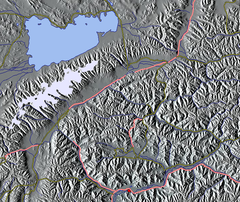Namtso
| Namtso | |
|---|---|

View of the lake and the holy rock near the Tashi Dor monastery (2005)
|
|

Relief map. Lhasa is the area marked in red at the bottom.
|
|
| Location | Damxung/Baingoin, Tibet, China |
| Coordinates | 30°42′N 90°33′E / 30.700°N 90.550°ECoordinates: 30°42′N 90°33′E / 30.700°N 90.550°E |
| Type | salt lake |
| Primary inflows | snow cover and spring of Tanggula Mountains |
| Primary outflows | None (endorheic) |
| Basin countries | People's Republic of China |
| Max. length | 70 km (43 mi) |
| Max. width | 30 km (19 mi) |
| Surface area | 1,920 km2 (740 sq mi) |
| Average depth | 33 m (108 ft) |
| Max. depth | 125 m (410 ft) |
| Water volume | 768 billion cubic metres (623×106 acre·ft) |
| Surface elevation | 4,718 m (15,479 ft) |
| Islands | 5 |
| Namtso | |||||||||||
| Tibetan name | |||||||||||
|---|---|---|---|---|---|---|---|---|---|---|---|
| Tibetan | གནམ་མཚོ་ | ||||||||||
|
|||||||||||
| Chinese name | |||||||||||
| Traditional Chinese | 納木錯 | ||||||||||
| Simplified Chinese | 纳木错 | ||||||||||
|
|||||||||||
| Transcriptions | |
|---|---|
| Wylie | gnam mtsho |
| THDL | Namtso |
| Tibetan Pinyin | Nam Co |
| Lhasa IPA | [namtsʰo] |
| Transcriptions | |
|---|---|
| Standard Mandarin | |
| Hanyu Pinyin | Nàmù Cuò |
Namtso or Lake Nam (officially: Nam Co; Mongolian: Tenger nuur; “Heavenly Lake”; in European literature: "Tengri-Nor", 30°42′N 90°33′E / 30.700°N 90.550°E) is a mountain lake on the border between Damxung County of Lhasa prefecture-level city and Baingoin County of Nagqu Prefecture in the Tibet Autonomous Region of China, approximately 112 kilometres (70 mi) NNW of Lhasa.
Namtso was born in the Paleogene age, as a result of Himalayan tectonic plate movements. The lake lies at an elevation of 4,718 m (15,479 ft), and has a surface area of 1,920 km2 (740 sq mi). This salt lake is the largest lake in the Tibet Autonomous Region. However, it is not the largest lake on the Qinghai-Tibet Plateau. That title belongs to Qinghai Lake (more than twice the size of Namtso); which lies more than 1,000 km (620 mi) to the north-east in Qinghai.
Namtso has five uninhabited islands of reasonable size, in addition to one or two rocky outcrops. The islands have been used for spiritual retreat by pilgrims who walk over the lake's frozen surface at the end of winter, carrying their food with them. They spend the summer there, unable to return to shore again until the water freezes the following winter. This practice is no longer permitted by Chinese authorities.
...
Wikipedia
